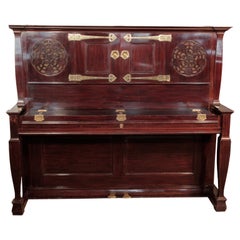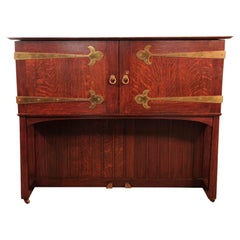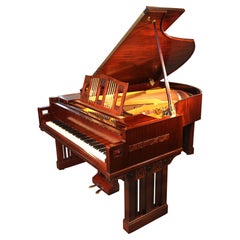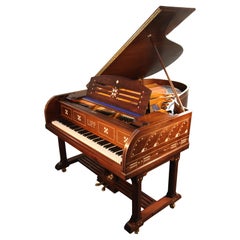Want more images or videos?
Request additional images or videos from the seller
1 of 13
Arts and Crafts Bechstein Upright Piano Walnut Case Design by Walter Cave
Price:$9,232.88
$11,541.10List Price
About the Item
- Creator:Walter Cave (Designer)
- Dimensions:Height: 47.25 in (120 cm)Width: 60.24 in (153 cm)Depth: 24.41 in (62 cm)
- Style:Arts and Crafts (Of the Period)
- Materials and Techniques:
- Place of Origin:
- Period:
- Date of Manufacture:1898
- Condition:Wear consistent with age and use. Piano in playable condition.
- Seller Location:Leeds, GB
- Reference Number:Seller: Ref 26011stDibs: LU6879231878602
About the Seller
No Reviews Yet
Vetted Professional Seller
Every seller passes strict standards for authenticity and reliability
Established in 1979
1stDibs seller since 2022
5 sales on 1stDibs
Authenticity Guarantee
In the unlikely event there’s an issue with an item’s authenticity, contact us within 1 year for a full refund. DetailsMoney-Back Guarantee
If your item is not as described, is damaged in transit, or does not arrive, contact us within 7 days for a full refund. Details24-Hour Cancellation
You have a 24-hour grace period in which to reconsider your purchase, with no questions asked.Vetted Professional Sellers
Our world-class sellers must adhere to strict standards for service and quality, maintaining the integrity of our listings.Price-Match Guarantee
If you find that a seller listed the same item for a lower price elsewhere, we’ll match it.Trusted Global Delivery
Our best-in-class carrier network provides specialized shipping options worldwide, including custom delivery.You May Also Like
G M Ellwood, attri. An Arts & Crafts Walnut & Inlaid Piano made by J Brinsmead
By John Brinsmead, George Montague Ellwood
Located in London, GB
George Montague Ellwood, designer (attributed).
A rare Arts and Crafts Walnut and inlaid upright iron framed piano made by John Brinsmead and Sons, London...
Category
Early 20th Century English Arts and Crafts Musical Instruments
Materials
Walnut
$7,467
H 50.5 in W 57 in D 27 in
Antique English Victorian Hand Crank Mahogany Case Portable Upright Barrel Piano
Located in Philadelphia, PA
Antique English Victorian Hand Crank Mahogany Case Portable Upright Barrel Piano with Gold Gilt Trim. Circa Late 19th Century. Measurements: 45" H x 26" W x 18" D.
Category
Antique Late 19th Century Unknown Other Musical Instruments
Materials
Wood
$3,200
H 45 in W 26 in D 18 in
Artistic Design and All Handcrafted, Wrought Iron Arts & Crafts Candlestick
Located in Lisse, NL
With the holiday season on our doorstep we are offering a number of season related items, but also many smaller and lower priced art and antiques that will make great gifts for yours...
Category
Early 20th Century European Arts and Crafts Candlesticks
Materials
Wrought Iron
$755
Free Shipping
H 15.5 in Dm 7.5 in
A German 19th Century Louis XVI Style Burr Walnut Bechstein Concert Grand Piano
By Bechstein Piano Company
Located in Los Angeles, CA
A Very Fine German 19th Century Louis XVI Style Burr Walnut Bechstein Concert Grand Piano, Serial No. 5655. The beautifully crafted Grand piano, raised on three tapered barrel shaped legs, with an intricately carved ornate music desk and original keys. Circa: 1872.
Length: 80 inches (203.2 cm)
Width: 59 inches: (149.9 cm)
Height (top closed): 38 5/8 inches (98.1 cm)
C. Bechstein Pianofortefabrik
C. Bechstein Pianofortefabrik AG (also known as Bechstein) is a German manufacturer of pianos, established in 1853 by Carl Bechstein.
Before Bechstein
Young Carl Bechstein studied and worked in France and England as a piano craftsman, before he became an independent piano maker. His first pianos were made for other companies.
C. Bechstein
C. Bechstein piano factory was founded on 1 October 1853 by Carl Bechstein in Berlin, Germany.
Carl Bechstein set out to manufacture a piano able to withstand the great demands imposed on the instrument by the virtuosi of the time, such as Franz Liszt. In 1857, Hans von Bülow (Liszt's son-in-law) gave the first public performance on a Bechstein grand piano by performing Liszt's Piano Sonata in B minor in Berlin
By 1870, with endorsements from Franz Liszt and Hans von Bülow, Bechstein pianos had become a staple in many concert halls and private mansions. By that time three piano makers, all of which were founded in 1853, became established as the industry leaders across the world: Bechstein, Blüthner and Steinway & Sons.
In 1881 Bechstein began supplying pianos to Queen Victoria. A gilded art-case piano was delivered to Buckingham Palace, followed by several more Bechstein pianos to Windsor Castle and other royal residences. By January 1886 they were among the piano manufacturers holding a Royal Warrant as a supplier to the Queen. Several British embassies across the world acquired Bechstein pianos.
In 1885, Bechstein opened a branch in London, that eventually grew to become the largest showroom and dealership in Europe. By 1890 showrooms had been opened in Paris, Vienna, and Saint Petersburg. On 31 May 1901, Bechstein Hall, built at a cost of £100,000, was opened next to the company's London showroom at 36-40 Wigmore Street. Between 1901 and 1914, C. Bechstein was the largest piano dealership in London. At that time, Bechstein was patronized by the tsars of Russia, the royal families of Spain, Belgium, the Netherlands, Italy, Sweden, Norway, Austria and Denmark, and other royalty and aristocracy. The list of royal clients of Bechstein may be found on the soundboard of vintage Bechstein pianos made before the Second World War. The list is part of the original Bechstein trademark logo; it can be seen under the strings in the center of a piano's soundboard.
The signature of Carl Bechstein
The years from the 1870s through 1914 brought Bechstein their most dramatic increase in sales. In 1880 a second Bechstein factory was opened in Berlin, and the third factory was opened in 1897 in Berlin-Kreuzberg. Production reached 3,700 pianos annually in 1900, and 4,600 in 1910, making Bechstein the largest German manufacturer of high-end pianos. At that time, about three quarters of production went to international markets, especially Britain and the Commonwealth, and Russia.
Carl Bechstein died in 1900, and the Bechstein company continued to operate under the management of his sons.
Between 1900 and 1914 C. Bechstein was one of the leading piano makers in the world, employing 1,200 craftsmen and workers by 1913 and making five thousand pianos per year.
First World War
C. Bechstein suffered huge property losses in London, Paris, and St. Petersburg during World War I. The largest loss was in London. Although the company's position in the United Kingdom was initially unaffected, with the company still listed as holding a Royal Warrant in January 1915, Warrants to both King George V, and his wife Queen Mary were cancelled on 13 April 1915. Bechstein was not the only musical concern to be affected by growing anti-German sentiment: there were earlier attempts, led by William Boosey, to boycott German music altogether. In 1915, despite being a Baronet and Privy Counsellor, Sir Edgar Speyer, who was then funding the Proms, was forced to leave the country. Following the passing of the Trading with the Enemy Amendment Act 1916 the British arm of the company was wound-up on 5 June 1916, all Bechstein property, including the concert hall and showrooms full of pianos, were seized as "enemy property" and closed. In 1916 the hall was sold as alien property at auction to Debenhams for £56,500. It was renamed Wigmore Hall, and then re-opened under the new name in 1917. All 137 Bechstein pianos at the Bechstein showrooms were confiscated too, and became property of the new owner of the Hall. After a dispute with his brother, Edwin Bechstein left the company and was paid off.
Eventually the Bechstein factory resumed full-scale production during the 1920s. At that time, technical innovations and inventions of new materials and tools, as well as improvements in piano design and construction, had allowed Bechstein to become one of the leading piano makers again.
The most successful models were the updated "A"-185 and "B"-208 grand pianos. The upright pianos became more popular after the war, and C. Bechstein were successful with its upright pianos Model-8 and Model-9, both of which have been considered the finest upright pianos.
As the company was changed into a joint-stock company 1923, Edwin Bechstein and his wife Helene, bought themselves back into the company as shareholders.
In 1930 the company collaborated with German electrical goods manufacturer Siemens under Nobel laureate Walther Nernst to produce one of the first electric pianos...
Category
Antique 19th Century German Louis XVI Musical Instruments
Materials
Bronze
$49,850 Sale Price
33% Off
H 38.63 in W 80 in D 59 in
Exceptional Quality Antique C.Bechstein Victorian Rosewood Boudoir Grand Piano
Located in Suffolk, GB
Exceptional quality antique C.Bechstein Victorian rosewood boudoir grand piano Model V (1898) having a superb quality rosewood lift up top opening to reveal an ornate adjustable musi...
Category
Antique 19th Century German Victorian Musical Instruments
Materials
Other
$21,561 Sale Price
20% Off
H 39.38 in W 59.06 in D 78.75 in
Arts and Crafts Architecture by Maureen Meister
Located in valatie, NY
Arts and Crafts Architecture by Maureen Meister. Hardcover with dust jacket. Published by University Press of New England, 2014. This book offers the first full-scale examination of ...
Category
21st Century and Contemporary American Books
Materials
Paper
Arts and Crafts Walnut Dinner Gong This is a large hall piece the Brass Gong
Located in Godshill, Isle of Wight
Arts and Crafts Walnut Dinner Gong
This is a large hall piece the Brass Gong is hand beaten brass suspended in a beautiful walnut frame, with turnings decorating the top rail, it ...
Category
Antique 19th Century Arts and Crafts Musical Instruments
Materials
Brass
$2,715
H 86 in W 22 in D 10 in
American Arts & Crafts: Virtue in Design by Leslie Greene Bowman
Located in valatie, NY
American Arts & Crafts: Virtue in Design by Leslie Greene Bowman. Bulfinch Press, 1992. Stated First edition softcover. 255 pp., profusely illustrated with 190 color and 275 b&w plat...
Category
1990s American Books
Materials
Paper
Large German Iron Arts and Crafts Hanukkah Lamp
Located in New York, NY
This iron Hanukkah lamp, crafted in Germany in the 1920s, is a remarkable example of the Arts and Crafts movement’s aesthetic and emphasis on handcrafted artistry. The piece features...
Category
Vintage 1920s German Arts and Crafts Religious Items
Materials
Iron
An Arts and Crafts silver and moonstone brooch circa 1900
Located in Central England, GB
A most beautiful and fine silver arts and crafts brooch, unmarked (tested).
This fine bar brooch is set with seven good sized moonstones, it ha...
Category
Early 20th Century English Arts and Crafts Collectible Jewelry
Materials
Silver
More From This Seller
View AllArts and Crafts, Bechstein Upright Piano Rosewood Brass Hinges by Walter Cave
By Walter Cave
Located in Leeds, GB
An 1897, Arts and Crafts Bechstein upright piano with a polished, rosewood case, fretwork panels and ornate brass hinges in a stylised floral design. Unique design by Walter Cave, executed by C. Bechstein and exhibited by Maple & Co.
C. Bechstein is inscribed on a square, brass plaque on the piano fall.
The front panel features cupboard doors, which open so as to allow the music desk to fall into place. These doors occupy half the width of the front, so that they fold back out of the way of the player. The candle sconces are concealed behind the doors and brought into use when required.
The music desk is in an openwork folkloric inspired design of stylised birds, foliage and flowers.
The brass candle holders also feature cut-out stylised bird motifs.
The front panel is flanked by two circular fretwork panels backed in fabric that act as a sound box...
Category
Antique Late 19th Century German Arts and Crafts Musical Instruments
Materials
Brass
Broadwood 'Manxman' Oak Piano Arts and Crafts Designed by M. H. Baillie Scott
By Mackay Hugh Baillie Scott
Located in Leeds, GB
Arts and Crafts, 1904, 'Manxman' Broadwood piano with an oak case. Cabinet resembles a chest on a stand and is reminiscent of an old strong box from th...
Category
Early 20th Century English Arts and Crafts Musical Instruments
Materials
Brass
Arts and Crafts Ibach Grand Piano Mahogany Designed by Dutch Architect Cuypers
Located in Leeds, GB
A 1916, German Arts and Crafts, Ibach grand piano with a mahogany case and carved panel detail. The mahogany cabinet is polished so as to emphas...
Category
Early 20th Century German Arts and Crafts Musical Instruments
Materials
Brass
Arts and Crafts Style Lipp Grand Piano Inlaid Germanic Folklore Motifs
Located in Leeds, GB
Arts and Crafts style, Lipp grand piano for sale with a mahogany case inlaid with symbols and designs from Germanic folklore. Case features ornate brass hinges and slatted cross stretcher. The mahogany cabinet is polished in matt to emphasize the quality of the wood used. Cabinet features a simple geometric cross stretcher supporting the simple gate legs. The Arts and Crafts period championed the simplicity of form and the construction of the object. Here, the brass hinges are accentuated with two-tone brass and stamped geometric designs. Richard Lipp...
Category
Early 20th Century German Arts and Crafts Musical Instruments
Materials
Mahogany
Art Deco Barker Upright Piano Chrome Mahogany Geometric Case Styling
Located in Leeds, GB
A 1930's Barker upright piano with an Art Deco style mahogany case. Cabinet features strong angular styling, evident in the chamfered corners at the top and b...
Category
Early 20th Century English Art Deco Musical Instruments
Materials
Chrome
Gast Upright Piano Quartered Walnut Neoclassical Inlay Brass Candlesticks
Located in Leeds, GB
Albert Gast upright piano with a quartered, walnut case and ornate, brass candlesticks. Entire cabinet inlaid in neoclassical designs. Piano has an eighty-eight keyboard and two pedals.
Front panel features inlay of a central urn surrounded by scrolling acanthus and flowers. The cabinet pilasters are carved Corinthian style with a palmette flourish. The scroll piano cheeks are carved with curlicue strapwork and inlaid with foliage and flowers. The piano legs...
Category
Antique Late 19th Century German Neoclassical Musical Instruments
Materials
Brass
Recently Viewed
View AllMore Ways To Browse
Antique Upright Piano
Square Piano
Antique Square Pianos
German Piano Upright
Antique Bechstein Piano
Bechstein Piano
Used Bechstein Pianos
Walter Cave Piano
Ph Pianos
Poul Henningsen Piano
Record Bar
Swiss Music Boxes
Brass Music Box
Tube Radios
Bakelite Vintage Radio
Radio 1970
Wood Record Player
Antique Cylinder Music Boxes



